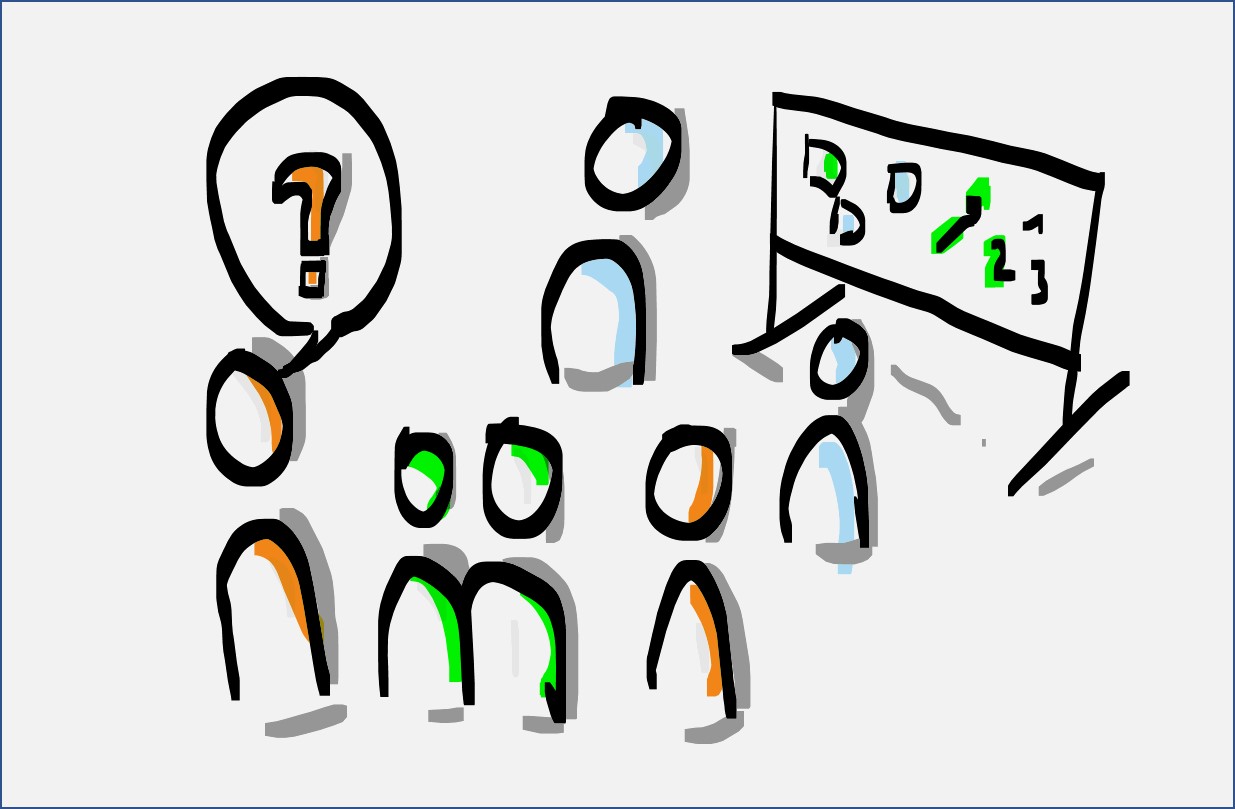“Lead by asking.” That makes sense.
Nevertheless, you could – and should – also lead by answering the right way.
Years ago, I did a course to learn how to facilitate workshops professionally: Clarifying the assignment, structuring & designing, facilitating including methodology, technique and materials, etc.
In the meantime, I have gained my own experience and found my own approaches and tricks that work for me (and hopefully also for my clients). And yet I am always surprised how often I fall back on the many helpful basics I had learned back then. (See notes)
A few things in particular have stuck with me. Because I literally use them almost every day. For example:
Professional Question Treatment
It is about addressing participants’ questions in a way that everyone can gain as much insight as possible. So how does this work?
The challenge is to answer the question in such a way that both the questioner is satisfied with it. But also in such a way that, firstly, the other participants also get something out of it and, secondly, their general attention does not suffer. After all, every question is an interruption of the whole process you are in the middle of moderating.
1. Say Thank You
It would be nice if they can do it appreciatively (i.e.: seriously).
After all, every question means that people are dealing with the (your!) topic. (Yes, also the critical questions, especially those).
And from every question you can also learn personally, e.g. how to explain better.
2. Clarify the Question
Experts (which we all are), love to be asked questions. Especially if they are specialist questions. In this way, the experts, which we all are, can finally show what we are capable of. But this is dangerous and out of place ( for now), especially in the treatment of questions.
Because (for now) it’s not about demonstrating what we know, but about helping the questioner to understand. That is a very big difference!
Therefore, avoid what I call the counsellor trap and first try to find out if you have correctly understood the question. And also why it is being asked in the first place.
 The tool to do this is: Repeat the question (briefly) in your own words, provide the interpretation and then seek confirmation from the questioner:
The tool to do this is: Repeat the question (briefly) in your own words, provide the interpretation and then seek confirmation from the questioner:
- “When you say that…,
- Do you mean…?
- Do I understand that correctly?”
This is clever and good in so many ways. Because (only) this way it is possible to work effectively, purposefully and thus time-saving in a positive way and, on top of that, in a very appreciative and relationship-building way.
3. Give Context, Orientate, “Chunk”
First of all, it is important to place the question in the appropriate thematic context and thus to classify it. This gives orientation, which is usually helpful on its own. (And often already answers the question).
This is true not only for the questioners, but for everyone. Because the context is what makes the question relevant to the overall topic.
Often we cannot see the wood for the trees
The “tool” of choice for this is “chunking“. Upwards.
Chunks are ” thematic fields” with which people mentally order and organise their world.
Chunking means “simplifying”. Generic terms are formed. In this way, one detaches oneself (for the moment) from the detailed area, where questions often arise. Example: woodpecker, sparrow, blackbird, thrush, finch and starling –> birds.
By chunking upwards, we arrange the question thematically. Example:
“Your question is aimed at a specific point of prevention. However, right now we are talking about prophylaxis. It’s easy to confuse the two, so let me make a little digression here…”

4. Answer
Now it’s time to answer. As a general rule, be detailed enough, but also INCREDIBLY as short as possible. (This art requires practice).
Otherwise, it can mean many things. For instance, simply answering briefly and succinctly. This is useful for “simple” technical questions.
In my experience, however, it is better to hold back my own answer first and include the questioner in the answer. And preferably the whole group:
- “Before I give my answer, I would be interested to know what you yourself think…?”
- “That’s a good question, what do the others say?”
- “That’s a tricky one. Have you or anyone else in the group experienced something similar? What happened there?
This offers several advantages:
- You act in a highly professional way because you avoid the consultant trap: It is not about your insight. But about the participants’, especially the questioners’.
- You keep people mentally engaged.
- You buy time if you don’t have an answer yourself yet.
After the answers have come from the circle of participants, you can still make additions from your expert point of view or correct what has been said. This way you have used all the know-how and potential available and all the perspectives of the group.
5. Close Properly
In the end, double-check with the questioner whether the question has been answered sufficiently. If not, you can either go back in or you can adjourn to another time.
 Come To Think Of It…
Come To Think Of It…
… I believe this is one of my “Magic Tricks“. Because:
- This is how I treat my participants appreciatively at eye level and as equals. This ensures a trusting, genuine learning atmosphere.
- This is how I get participants to work out solutions themselves. It creates confidence in one’s own problem-solving skills. This activates and motivates people to solve their problems and issues well. It simply feels good for everyone.
- And that’s what you are aiming for: People learn and feel good about it.
So, when I manage to answer questions like this, I am always a bit proud of myself. 🙂
What Else Comes To My Mind
 Come To Think Of It…
Come To Think Of It…